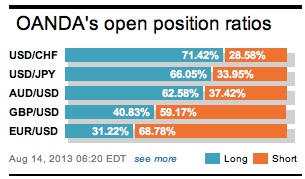Despite the lack of liquidity and the lack of general market interest of late, isolated global economic data is beginning to paint an interesting picture. It’s certainly no Picasso, no masterpiece, not quiet yet anyways, but considered in its own right, one could say that policy makers are trying desperately to paint the foundations for something significant that will supposedly have an influence. One needs only to cast their eye towards the foreigner at helm of the BoE to appreciate what efforts are required to win over general populous. Carney’s task has only just begun and he has yet to win over his very “own” crew.
Governor Carney has failed to persuade all eight other members of the BoE Monetary Policy Committee to back his introduction of a pledge not to raise interest rates until the UK’s unemployment number falls. An ‘outsider’ (from the central bank) Martin Weale voted against “forward guidance” as this months BoE minutes revealed earlier this morning. The minutes would be considered marginally on the hawkish side as market expectations had been leaning towards a unanimous vote in favor of forward guidance. The vote was 8-1, with Weale dissenting in favor of a shorter time horizon for the forward guidance to hold. What will probably make Carney’s job that bit harder is that Weale is not even considered the most hawkish of the hawks on the committee- both Bean and Tucker come in ahead of Weale. This would make the MPC forward guidance policy that bit more tenuous.

The financial markets will surely now begin to question the validity of the MPC to stick with its pledge to keep the BoE’s benchmark interest rate at +0.5% until the UK’s unemployment rates falls to +7%. This morning’s Q2 unemployment rate announcement remained at +7.8%, well above the desired BoE threshold. The number of Britons out of work fell by -4k to +2.51m. It was only last week that the BoE formally made the unemployment rate a key component and indicator for the future path of monetary policy in the UK. Carney indicated that he and his policy cohorts would not consider raising rates until the UK’s unemployment rate fell to +7%. The pledge is also conditional on their forecast that inflation stays below +2.5%. In effect, interest rates must not threaten the stability of the UK’s financial system.
The net result had both UK gilts and short sterling positions under pressure immediately after the release, but not to the extent of the reversal witnessed after last weeks BoE quarterly inflation report and forward guidance announcement. Asian investor supply has thus far helped to cap GBP’s post MPC gains at 1.5507. Stops are mooted above 1.5520. This week’s high so far is the 1.5521 print recorded on Monday.

This morning’s flash estimates of Q2 French GDP reveled that their economy has expanded +0.5% on the quarter, solidly beating market expectations of a +0.2% growth. Even the year-on-year print beat forecasts for a flat reading, coming in at +0.3%. The same data for Germany was in line on the quarter, showing +0.7% growth, but better on the year at +0.5% expansion. The market was expected to do very little with this announcement – it preferred to wait for the flash estimate of the Euro-zone numbers as a whole.
As expected, the flash estimate data confirms that the Euro bloc has finally emerged from their recession, as the region returned to growth in Q2 (flash GDP q/q was +0.3% vs. +0.2% expected). The EUR is finding it difficult to record “persistent traction,” as investors seem to be reining in their overall Euro-optimism. The German economy maybe cruising, but the peripheral economies like Spain and Italy still have their own deeper issues (austerity, debt and high unemployment to name a few). Even Greece requiring another aid package, the German general election outcome and the upcoming German constitutional court decision in October all point to a higher EUR ‘risk’ premium requirement to be further priced in the end of Q3 and whole of Q4. One only has to ponder the outcome of Greece heading towards its own election – the 17-member single currency would depreciate at a rather rapid pace.

What about the EUR? The prospect of a neutral to slightly dovish ECB and of reduced stimulus from the Fed in theory should be able to cap any EUR upside potential. Technical analysts would consider a daily close below1.3295, the 10-DMA, as a bear market. Today’s economic releases have EUR speculators comfortable selling the single currency on rallies. In time, they are looking for the EUR to retreat towards its 30-DMA at 1.3167. From a macro-economic perspective, markets will now likely shift their focus towards how the recovery is shaping up in Q3. Next week delivers the flash PMI’s for this month.

Other Links:
EUR Struggles To Trade Higher; Data Matches Rumours
Dean Popplewell, Director of Currency Analysis and Research @ OANDA MarketPulseFX
This article is for general information purposes only. It is not investment advice or a solution to buy or sell securities. Opinions are the authors; not necessarily that of OANDA Corporation or any of its affiliates, subsidiaries, officers or directors. Leveraged trading is high risk and not suitable for all. You could lose all of your deposited funds.


